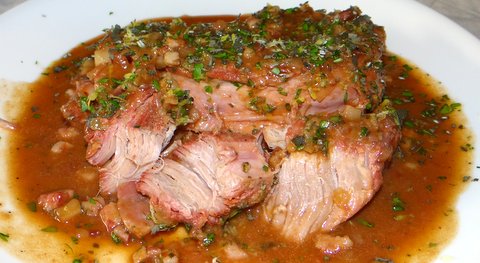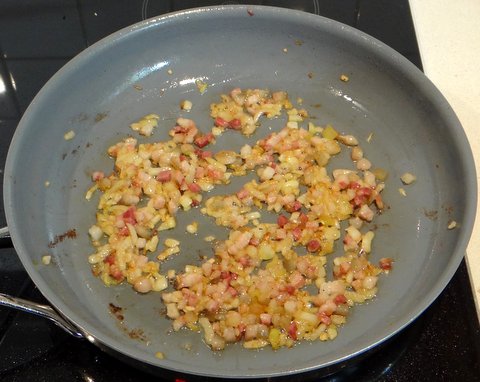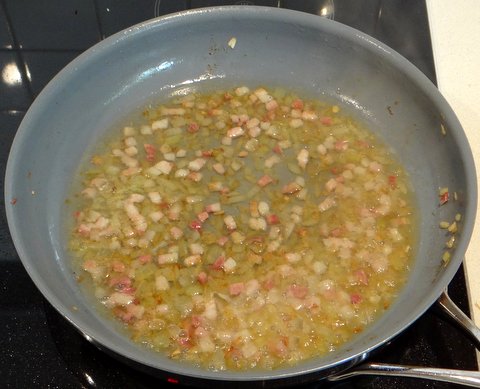Ossobuco is a classic Italian dish from Milan that most people know as veal shanks braised in tomato sauce. Originally, the veal shanks were actually braised in veal stock with just a hint of tomato. I like this classic version, because it gives a meatier flavor. With sous-vide cooking, you could braise the veal shanks at a lower temperature to obtain a different texture. This time, I’ve used Modernist Cuisine’s recommendation for veal shanks, which is 72 hours at 62C/144F.
The meat comes out with a classic flaky structure and is very flavorful but just a bit dryish, and that’s okay since there is plenty of sauce to eat the meat with. Of course you could also do a traditional braise in the oven or on the stove using the same recipe.
Ingredients
For 2 servings
2 veal shanks
50 grams (2 oz) pancetta, diced
1 glass (100 ml) dry white wine
1 onion, chopped
120 ml (1/2 cup) concentrated veal stock (if you don’t make this yourself, buy good quality low-sodium liquid stock in a can or jar rather than a bouillon cube!)
1 heaped teaspoon of double-concentrated tomato paste (or 2 tsp normal)
salt and freshly ground pepper
flour for dusting
butter
extra virgin olive oil
For the gremolata
fresh flatleaf parsley
1 sprig of fresh rosemary
2 fresh sage leaves
lemon zest
1 clove garlic (optional)
Preparation
Make cuts in the membrane about every 2 cm (1 inch) around the shanks because the membrane will shrink when you brown the shanks, and otherwise they will be deformed.
Pat the shanks dry with paper towels. Season with salt and freshly ground black pepper and dust with flour. Heat olive oil in a frying pan and brown the shanks, a few minutes on each side.
Discard most of the oil from the pan and add butter. Add onion when the butter foams and sauté until translucent.
Add pancetta and keep sautéing until barely golden.
Deglaze the pan with white wine.
As soon as half the wine has evaporated, add veal stock and tomato puree, and stir to mix.
Put the meat with this mixture in a sous-vide zip pouch, releasing most of the air from the pouch by submerging it in water. If you don’t have zip pouches, you could also freeze the mixture if you are using a FoodSaver-style vacuum sealer (make sure it’s thoroughly frozen, this takes more than a few hours) or use a chamber vacuum sealer.
Cook sous-vide for 72 hours at 62C/144F.
For a traditional braise, add the shanks to the sauce and put in an oven at 70C/160F until tender.
When you are ready to serve, mince the ingredients for the gremolata and mix in a bowl. I usually omit the garlic, which is a traditional ingredient of gremolata, because I don’t like raw garlic.
If the sauce isn’t thick enough, cook it in a saucepan until it is to your liking. Taste and adjust seasoning with salt and freshly ground black pepper.
Serve the shanks on warm plates with the sauce, sprinkled with gremolata.















Another fine looking dish. The meat looks amazingly tender. The sauce just has to be excellent.
Best,
Conor
LikeLike
It was. This was the first time I added pancetta, and it really makes a difference.
LikeLike
So you have succeeded in creating another mouth-watering dish and inspired me to make ossobuco in the verry near future. And I mean maybe I’m just jealous you have a sous-vide machine as this does look great and I’m sure it tasted even better, but for me there’s just no benefit in using sous-vide for this dish. I think such deeper flavours can be achieved by doing a normal braise and once cooked leaving it overnight to collect even more and just re-heating to serve.
LikeLiked by 1 person
I admit the benefit for this particular dish is for a substantial amount in the ease. With sous-vide I don’t have to watch it at all and it will come out perfect every time. With a normal braise it is easy to overcook it and hard to predict when it wil be tender.
But you can definitely get good results making ossobuco the traditional way.
LikeLike
Puree? did you mean paste, how do you get a heaping tablespoon of puree. TYIA
LikeLike
Yes I meant paste. The Dutch word for tomato paste is “tomatenpuree”. Thanks for catching this, just fixed it!
LikeLike
I’m not very familiar with Ossobuco but have heard of it and saw it made without tomato. I’ll have to try this some day. I’m more familiar with Neopolitan cooking.
LikeLiked by 1 person
Ciao stefan: I want to try this but I do not understand one thing: I do not have sous vide bags, but I do have sous vide plastic rolls that ai can cut, seal and vacuum. Do u reccomend freezing them (with the meat and juices) before vacuum sealing them? Doesnt the meat suffer from being cooked from frozen?
LikeLike
My recommendation is to only freeze the sauce/liquid before vacuum sealing, not the meat. You then vacuum seal the meat with the frozen sauce.
LikeLike
! thanks for clarifying. i will do that (and I will buy some sous vide zip bags). right now I am cooking sous vide borlotti (tried before: good texture). I also tried sous vide poached rhubarb (very good). off I go to make the sauce. ciao, s
LikeLiked by 1 person